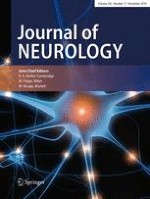Erschienen in:

12.09.2018 | Original Communication
Dorsal root ganglia in vivo morphometry and perfusion in female patients with Fabry disease
verfasst von:
Tim Godel, Anja Köhn, Nicole Muschol, Moritz Kronlage, Daniel Schwarz, Jennifer Kollmer, Sabine Heiland, Martin Bendszus, Victor-Felix Mautner, Philipp Bäumer
Erschienen in:
Journal of Neurology
|
Ausgabe 11/2018
Einloggen, um Zugang zu erhalten
Abstract
Purpose
To examine dorsal root ganglia and the proximal nerve segments in female patients with Fabry disease by functional and morphometric magnetic resonance neurography.
Methods
In this prospective multicenter study the lumbosacral dorsal root ganglia and proximal sciatic nerve were examined in ten female patients with Fabry disease by a standardized magnetic resonance neurography protocol at 3 T. Volumes of dorsal root ganglia L3–S2, permeability of dorsal root ganglia L5 and S1 and the spinal nerve L5 as well as the cross-sectional area of the proximal sciatic nerve were compared to 16 gender-matched healthy controls.
Results
Dorsal root ganglia were symmetrically enlarged by 54% (L3), 79% (L4), 60% (L5), 94% (S1), and 106% (S2) (p < 0.001). Additionally, permeability of the blood–tissue interface was decreased by 47% (p < 0.001). This finding was most pronounced in the peripheral zone of the dorsal root ganglia, where the cell bodies of the primary sensory neurons are located (p < 0.001). While spinal nerve permeability showed no differences compared to healthy controls, proximal sciatic nerve cross-sectional area was mildly increased by 6% (p < 0.01).
Conclusion
Although heterozygous, Fabry females show severe enlarged dorsal root ganglia with a concomitant dysfunctional perfusion, even in patients with minor disease progression and in patients who are not considered for enzyme replacement therapy yet. Alterations in dorsal root ganglia volume and perfusion might serve as a very early in vivo marker for involvement of the peripheral nervous system in Fabry disease, even in patients with residual enzyme activity.